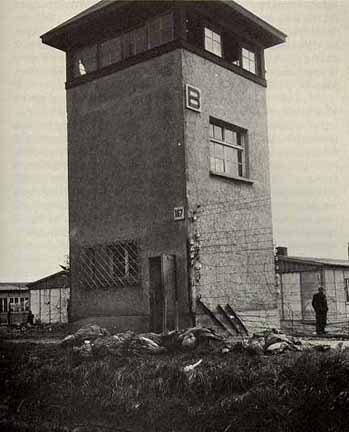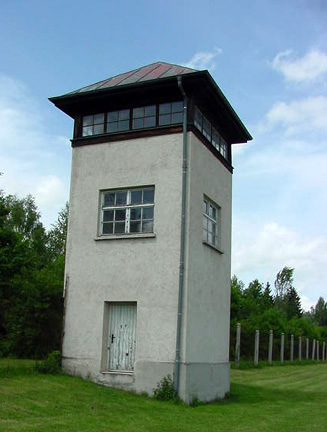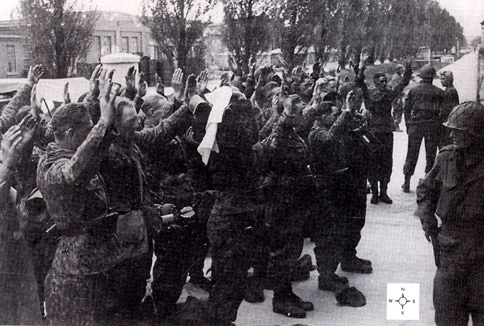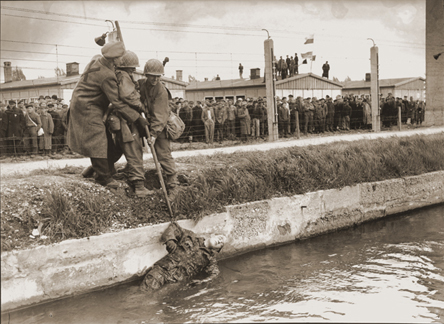The killing of the guards in Tower B11. After entry into the camp, personnel of the 42nd Division discovered the presence of guards, presumed to be SS men, in a tower to the left of the main gate of the inmate stockade. This tower was attacked by Tec 3 Henry J. Wells 39271327, Headquarters Military Intelligence Service, ETO, covered and aided by a party under Lt. Col. Walter J. Fellenz, 0-23055, 222 Infantry. No fire was delivered against them by the guards in the tower. A number of Germans were taken prisoner; after they were taken, and within a few feet of the tower, from which they were taken, they were shot and killed. Quoted from the IG Report of the U.S. Seventh Army   The photograph at the top of the page shows the bodies of six SS soldiers at the base of Tower B in the Dachau concentration camp after they were gunned downed by American soldiers. The bodies of two other SS men from Tower B had fallen into the Würm canal beside the tower. The second photograph above shows how the restored guard tower B looks today. When the camp was in operation, the door into the tower was outside the fence. During the reconstruction, the door was put inside the prison enclosure. On April 29, 1945, the day that the Dachau concentration camp was liberated by American troops, white flags had been flying from all seven of the Dachau guard towers since 7 o'clock in the morning. When American soldiers first entered the camp, eight SS men descended from Tower G, the one closest to the gatehouse, and then surrendered with their hands in the air. One of the guards in Tower G was an SS man named Stahl, who survived to tell the story. Eight guards from Tower A, which is on top of the gatehouse, then came down the stairs and surrendered to the Americans. The guards in Tower B also surrendered to the American liberators, but were gunned down.  The photograph above shows Waffen-SS soldiers who had been sent to Dachau to surrender the camp to the Americans. All of the regular guards had escaped from the camp the night before. There were 128 SS men in the camp prison who were released and ordered to guard the camp after the regular guards left. The view in the photo above is looking north. On the right side of the photo is the road that ran alongside the prison compound on the west side. Tower B is located midway down this road, but not shown in the picture. The building in the upper left corner of the photo has since been torn down and there is now a wall in the location where the line of poplar trees is shown in the photo. Another wall and an iron gate now separate this part of the prison camp from the gatehouse, which is behind the camera in this photo. The crematorium building where the gas chamber is located is at the end of the road alongside the prison enclosure, on the west side of the Würm river which is shown in the photo below. The photograph below shows two soldiers from the 42nd Rainbow Division and one of the released prisoners pulling the body of a dead Waffen-SS soldier from the Würm river which flows in a concrete-lined canal along the west side of the camp. The American soldier on the far right is 19-year-old Richard F. Dutro of 232 Infantry, E Company from Zanesville, Ohio.  Dr. Victor Maurer, a Red Cross representative from Switzerland, had arrived at the Dachau prison compound on April 27, 1945, two days before the liberation. Maurer had tried to persuade Obersturmführer Johannes Otto, the Adjutant to the last Commandant, Edward Weiter, to leave guards in the towers in order to secure the camp until the Americans arrived, but most of the regular guards left on April 28th, along with Martin Gottfried Weiss, the acting Commandant. The Commandant of the camp, Eduard Weiter, had already left on April 26th with a transport of prisoners headed toward Austria. Finally, Maurer convinced SS 2nd Lt. Heinrich Wicker not to abandon the camp, but to leave guards posted in the towers to keep order until the prisoners could be turned over to armed American soldiers. Wicker was in charge of a group of SS men who had recently arrived at Dachau; they were former guards in three sub-camps of the Natzweiler-Struthof camp in Alsace. The guards who were gunned down by Wells and the other American soldiers had only been at Dachau for a few weeks and they were, in no way, responsible for the conditions in the camp. Maurer knew that there were around 800 common criminals, including convicted murderers, who had been imprisoned at Dachau. He was fearful that an estimated 40,000 vengeful Dachau inmates would be released to wreak havoc in the surrounding area which was still a battle zone. There was also a typhus epidemic in the camp and Maurer did not want the prisoners to be released until the epidemic could be brought under control. When an advance party from the 42nd Division arrived in a jeep on the street that borders the south side of the SS complex, they saw Maurer and Wicker waiting to surrender the camp under a white flag of truce. At the same time, I Company of the 157th Regiment of the 45th Division was arriving at the railroad gate into the SS camp, on the west side of the complex, almost a mile from the prison enclosure. After Waffen-SS soldiers who had surrendered to I Company were gunned down in the coal yard of the SS camp, Lt. William Walsh led his men toward the prison enclosure east of the SS camp. There they met some of the soldiers of the 42nd Division along the barbed wire fence on the west side of the concentration camp. The shooting of disarmed German soldiers during the Dachau liberation was investigated by the Office of the Inspector General of the Seventh Army. Their report was finished on June 8, 1945 but was marked Secret. The report has since been made public and a copy of it was reproduced in Col. John H. Linden's book entitled "Surrender of the Dachau Concentration Camp 29 April 1945." Here are four paragraphs from the report which pertain to the shooting of the guards at Tower B. 11. After entry into the camp, personnel of the 42nd Division discovered the presence of guards, presumed to be SS men, in a tower to the left of the main gate of the inmate stockade. This tower was attacked by Tec 3 Henry J. Wells 39271327, Headquarters Military Intelligence Service, ETO, covered and aided by a party under Lt. Col. Walter J. Fellenz, 0-23055, 222 Infantry. No fire was delivered against them by the guards in the tower. A number of Germans were taken prisoner; after they were taken, and within a few feet of the tower, from which they were taken, they were shot and killed. 12. Considerable confusion exists in the testimony as to the particulars of this shooting; however Wells, German interrogator for the 222 Infantry, states that he had lined these Germans up in double rank, preparatory to moving them out; that he saw no threatening gesture; but that he shot into them after some other American soldiers, whose identities are unknown, started shooting them. 13. Lt. Colonel Fellenz was entering the door of the tower at the time of this shooting, took no part in it and testified that he could not have stopped it. 18. It is obvious that the Americans present when the guards were shot at the tower labored under much excitement. However Wells could speak German fluently, he knew no shots had been fired at him in his attack on the tower, he had these prisoners lined up, he saw no threatening gesture or act. It is felt that his shooting into them was entirely unwarranted; the whole incident smacks of execution similar to the other incidents described in this report. None of the American soldiers who killed the guards who surrendered at Dachau were ever put on trial for violating the Geneva Convention. The guards and staff members who survived the massacre at the liberation of Dachau were put on trial by an American Military Tribunal conducted at Dachau and all were convicted of participating in a common design to violate the Laws and Usages of War under the Geneva Convention of 1929. Execution of Waffen-SS soldiersBack to Liberation of DachauBack to Table of ContentsHomeThis page was last updated on March 11, 2008 |